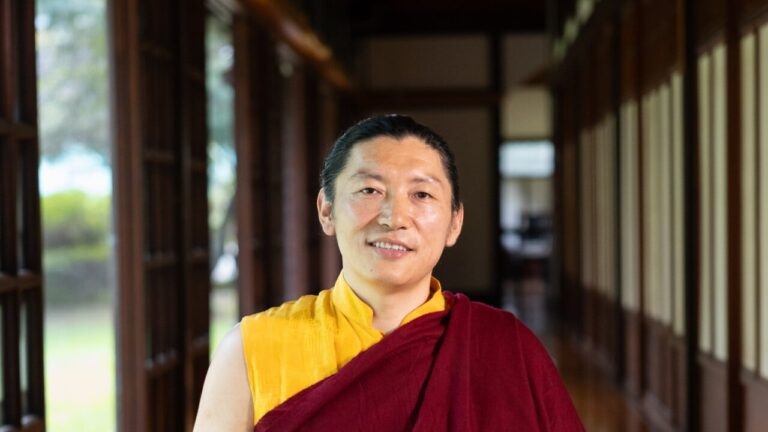Phakchok Rinpoche was born in 1981 to Kyapjé Tsikey Chokling Rinpoche and Sangyum Dechen Paldrön, within the family lineage of the great treasure revealer (terchen) Chokgyur Dechen Zhikpo Lingpa. Rinpoche was recognized as the reincarnation of the 6th Kyapgön Phakchok Rinpoche, one of the three throne holders (kyapgöns) of the Taklung Kagyü seat (densa) at Marthang Kham Riwoche monastery. Among Rinpoche’s previous incarnations, the 4th Kyapgön Phakchok Rinpoche was a devoted disciple and patron of Terchen Chokgyur Lingpa. During that period, it was the unwavering support of the upholders of Riwoche Monastery that created the auspicious circumstances for Chokgyur Lingpa’s awakened activity to spread and flourish.
Under the guidance of his root gurus—Kyapjé Tulku Urgyen Rinpoche, Kyapjé Nyoshul Khen Rinpoche, and Kyapchok Soktse Rinpoche—Phakchok Rinpoche has received and practiced the profound Dharma teachings handed down in an unbroken lineage from Mahaguru Padmasambhava. Inspired by the life and legacy of Guru Padmasambhava, Terchen Chokgyur Lingpa and the upholders of Riwoche Monastery, Rinpoche has devoted his own life to spreading the teachings of Guru Rinpoche, particularly the Profound Treasures of Chokgyur Lingpa (Chokling Tersar).
Mahaguru Padmasambhava is renowned for his role in guiding the establishment of Samye Monastery, thereby creating the auspicious causes and conditions (tendrel) for more than a thousand years of authentic practice to unfold in the land of Tibet in an incredible lineage of accomplishment that continues to this present day. Reflecting upon these auspicious beginnings, Phakchok Rinpoche has given his organization the same name, Samye, which means inconceivable. Just as this ancient Tibetan institution lived up to its name, becoming a truly inconceivable source of the Buddhadharma, Rinpoche’s aspiration is for today’s Samye mandala to do likewise and become an inconceivable beacon of wisdom, compassion and dignity for our present world and into the future.
In honor of Mahaguru Padmasambhava, Rinpoche has chosen a seal to represent Samye that traces back to Guru Rinpoche himself. This esteemed emblem was originally revealed by the Mahaguru and given to Dharma King Trisong Detsen’s royal heir, Lhasé Murup Tsenpo. Murup Tsenpo subsequently concealed it as a treasure (terma) for the benefit of future generations. Much later, in 18th century Tibet, it was discovered as a treasure by Lhasé Murup Tsenpo’s reincarnation, Terchen Chokgyur Dechen Zhikpo Lingpa. Today, it serves as the emblem for the Profound Treasures of Chokgyur Lingpa and for all Dharma activities led by Phakchok Rinpoche and his sangha.
帕秋仁波切簡介
帕秋仁波切出生於1981年,屬於大伏藏師秋吉德千喜波林巴的家族,是依怙主慈克秋林仁波切和桑嫞德謙巴諄之子。仁波切被認證為第六世帕秋仁波切的轉世,也是康區馬塘類烏齊寺達隆噶舉法座的三位法座持有者之一。在仁波切的歷代轉世中,第四世帕秋仁波切是大伏藏師秋吉林巴的虔敬弟子和功德主。在該時期堅定護持著類烏齊寺的諸位傳承法主,為秋吉林巴的佛行事業創造了廣傳
和繁盛的吉祥緣起。。
帕秋仁波切在依怙主祖古烏金仁波切、依怙主紐修堪仁波切和勝怙主索則仁波切這三位根本上師的指導下,領受並實修由大上師蓮花生大士一脈相傳而不間斷的甚深佛法教導。受到蓮花生大士、大伏藏師秋吉林巴和類烏齊寺諸位傳承法主的生平和遺教所啟發,帕秋仁波切畢生致力於弘揚蓮師法教,尤其是當中的《秋林甚深伏
藏》。
大上師蓮花生大士以指導創建桑耶寺而聞名,因此開啟一千多年來的實修吉祥緣起,在西藏土地上展現持續至今的殊妙成就傳承。緣於桑耶寺這個吉祥的開端,帕秋仁波切因此將其佛法組織同樣命名為桑耶,意思是「不可思議」。仁波切的願望是讓今日的桑耶壇城,也能如同古老的西藏桑耶寺那樣,名副其實地成為以智慧、慈悲和尊嚴來指引當今世界和未來世代的不可思議明燈。
為了紀念大上師蓮花生大士,仁波切選擇了一枚印璽來代表桑耶,而這枚印璽可以追溯到蓮師本人。這個受人尊敬的標誌最初是由大上師取出,並賜予法王赤松德贊的王位繼承人穆茹贊普王子。
穆茹贊普隨後將其埋藏為伏藏,以利益後代。諸多年後於19世紀的西藏,這枚印璽由穆茹贊普王子的轉世大伏藏師秋吉德千喜波林巴取出。如今,它已成為《秋林甚深伏藏》和帕秋仁波切與其僧團所主導各種佛行事業的象徵。


